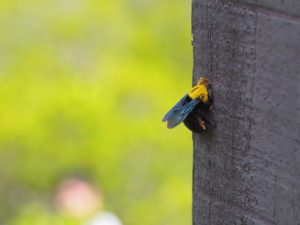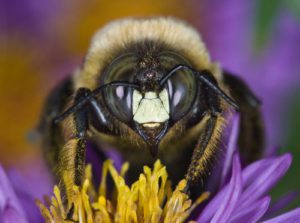These bees are familiar, you think. Then you remember that they seem to come out every spring around this time and in the same spot. They’re pretty aggressive, noisy, and diving and swooping at you when you come near.
When they chase you away, it might look like there are a lot of bees, but you’re probably only seeing a pair or two pairs of carpenter bees. These solitary bees don’t even have a hive to go home to. They’re busy creating a tunnel-like nest site in wood around your home but they won’t live there. After the female provisions the nest with pollen and several of her eggs, the pair will move on.
Homeowners may have to deal with some damage to their wood from carpenter bees. This damage can get worse when woodpeckers find the nest site. More on that later.
Have you noticed some big fat black bees buzzing around your yard or home? These large fuzzy black insects can sometimes be hard to identify. The two most common types of big black bees are bumble bees and carpenter bees. Knowing how to tell them apart will help you understand their habits and behaviors.
Appearance of Big Fat Black Bees
Bumble bees are very fuzzy, almost cute looking bees. They have black and yellow striped bodies that appear more round and plump Bumble bees can reach about 1 inch in size
Carpenter bees have a shiny black abdomen with less hair. They have a more streamlined and elongated body than bumble bees. Carpenter bees are also about 1 inch long. The female carpenter bee has a stinger, while males do not.
Nesting Habits
Bumble bees create nests underground in abandoned rodent burrows or cavities. Their nests contain wax pots to store nectar and pollen. Bumble bee colonies contain 50-500 individuals.
Carpenter bees drill nests into wood, such as fences, barns, sheds, and homes. The female carpenter bee chews into wood grains to build tunnels and chambers for their eggs. Carpenter bees nest alone, not in colonies.
Behavior and Roles
Bumble bees live in colonies with a queen, female workers, and male drones. The queen starts a new nest each spring. Workers forage for nectar and pollen. Drones mate with the queen. Bumble bees are important pollinators.
Carpenter bees do not have colonies or social structures. Females build and provision the nests. Males hover around nest sites and mate with females. Carpenter bees can sometimes damage wood while nesting but do not eat it. They get nectar from flowers but are not major pollinators.
Stings
Female bumble bees can sting but rarely do unless the nest is disturbed. When they do sting, their barbed stinger gets pulled out, causing the bee to die shortly after Bumble bee stings are painful but not very dangerous
Carpenter bees are less defensive and reluctant to sting. Females can sting multiple times since their stinger is smooth and remains attached. Male carpenter bees are territorial but cannot sting. Stings cause temporary pain and swelling.
Prevention and Removal
To deter bumble bees, avoid disturbing underground nesting areas. Bumble bee nests typically die out by winter.
Carpenter bee nests can be prevented by sealing exposed wood surfaces. Traps can also lure carpenter bees away from structures. Existing nests should be removed and holes filled to prevent re-nesting. Professional extermination may be needed for large infestations.
CARPENTER BEES AREN’T AROUND FOR VERY LONG
Depending on location and weather, our carpenter bees emerge from their winter quarters in early spring. They mate, and each pair starts building a nest and laying eggs, which mostly happens in late spring, in April and May. Most of the activity takes place over a two-week period.

As soon as the pair of carpenter bees finds a place to nest, the female starts digging the nest in the woods while the all-bluff male stays nearby to watch. Her goal is to make a gallery a few inches long that has six to eight separate larval cells, each with a wall between them. The hole she starts with is round and exactly the same size as her body, about the size of a dime. This hole and perhaps some coarse sawdust is the only visible part of the nest. Once the gallery is inside the wood, she makes a sharp right-angle turn and then builds brood cells along the wood’s grain.
The nest needs to be stocked with food for the young bees since mom won’t be around to feed them later. She starts at the back of her gallery tunnel and puts down a ball of pollen on which to lay an egg. She then closes the cell off with a piece of chewed wood. Then repeat for a total of 6 to 8 cells. The eggs will hatch into tiny bee grubs that can’t do anything on their own. Each one will be locked in its own cell and given a ball of pollen by its mother. The larva has grown to almost fill its cell by the time the pollen is eaten after a few weeks. It then turns into a pupa inside its cell.
Watch a pair as they build a nest. If you watch the female come and go, you can probably figure out where the nest is. But you might have to bend over to see the round nest opening because it’s usually on the bottom or unpainted back of a piece of wood.
Sometimes the female decides to rent instead of build anew. She skips the work and lays her eggs in a gallery that was already there from the previous year, often making it longer as she goes. Newly mated carpenter bees tend to build nests in the same location where they emerged. So, a site with lots of good wood can become home to many pairs of nesting carpenter bees every year. That could be a problem.
Despite the nonstop nest building activity that goes on for several days, when it’s over, it’s over. Pollen balls are put in place, eggs are laid, and brood cells are sealed. The female then seals the circular opening of the nest, and the pair moves on, leaving few signs. Job done, the pair will die within a few weeks.
As the summer goes on, hungry woodpeckers may come across the carpenter bees’ larvae, and in late summer, bees that have been pupating in the nest and have survived woodpeckers and other predators finally chew their way out of the gallery and emerge as adult bees. Just when you think you have seen the last of the carpenter bees until maybe next spring, two things can happen. These late summer adult bees aren’t into nest building. They will visit flowers and feed on pollen. At this time of year, if you see them going into a nest hole, it’s to clean out the old galleries so they can use the safe nest as a place to spend the winter.
YOU’D HAVE TO WORK TO GET ONE TO STING YOU!
The bee that is bothering you is the male, who is watching over the nest from outside while the female works. He puts on a good show to keep you away, but he’s all bluff. To add to the threat, he buzzes loudly and may hover right in your face. Don’t worry, he can’t hurt you because he doesn’t have a stinger, which is a female ovipositor that has been changed. Stingers are used to lay eggs.

A professor of entomology shocked his students on a field trip when he grabbed a flying carpenter bee and held it buzzing in his hand. With a smile, he revealed the trick. He knew this was a stingless male carpenter bee because he saw a yellow blaze on its “forehead. ”.
The female carpenter bee doesn’t have the yellow facial marking. Otherwise, the two sexes look alike. You shouldn’t try this trick unless you’re really sure, though, since female bees do have an ovipositor. She is reluctant to sting but will defend her nest if it’s directly threatened. It’s almost certain that the bee you see patrolling the nest site is a male.
These carpenter bees are our common eastern carpenter bees, Xylocopa virginica, which are large and black and yellow. There are western species of carpenter bees that are mostly dark or metallic in color.
Carpenter bee Xylocopa documentary
FAQ
Do big fat black bees sting?
What are the large black bees called?
Are black carpenter bees bad?
Can carpenter bees sting or bite you?
